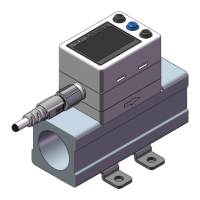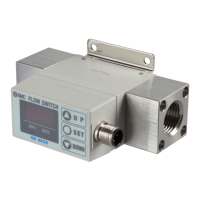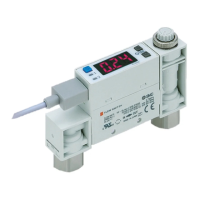The difference between ON and OFF points used to prevent chattering. Hysteresis can
be effective in avoiding the effects of pulsation.
Mode where the switch output will turn ON when the flow is greater than the set value,
and will turn off when the flow falls below (set value – hysteresis value).
The flow passing per unit of time. If it is 10 L/min, there is a flow of 10 L passing through
the device in 1 minute.
Insulation resistance of the product. The resistance between the electrical circuit and
the case.
The voltage drop across the product (and therefore not applied to the load), when the
switch output is ON. The voltage drop will vary with load current, and ideally should be
0 V.
This function prevents the set value from being changed by mishandling.
The maximum voltage that can be connected to the output of an NPN device.
The maximum current that can flow to the output (output line) of the switch output.
Max. (Min.) load
impedance
The maximum (minimum) load (resistance value and impedance) which can be
connected to the output (output wire)of the analogue current output.
Operating condition in which flow is being detected and displayed, and the switch
function is working.
Shows how precisely the flow can be displayed or set by the digital flow switch. When
1 digit = 1 L/min, the flow is displayed in increments of 1 L/min, e.g., 1, 2, 3, …, 99, 100.
Humidity range in which the product can operate.
Ambient temperature range in which product is operable.
The resistance value of a component between the voltage output element and the
analogue voltage output. It is indicated as a resistance value which is converted in
accordance with the condition in which resistance is directly connected to the voltage
output element. There may be an error in the output voltage depending on this output
impedance and the input impedance of customers' equipment. (example: If the flow
switch with output impedance of 1 kΩ is connected to the A/D converter to detect the
analogue output of 5 V, the detected voltage by the A/D converter becomes 5(V)
x1(MΩ)/(1(kΩ) + 1(MΩ)) ≒4.995(V), and there is an error of approximate 0.005 V).
